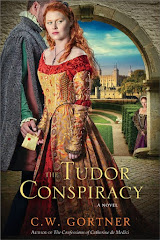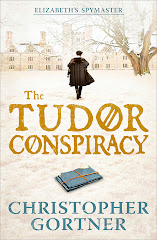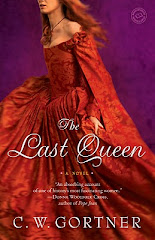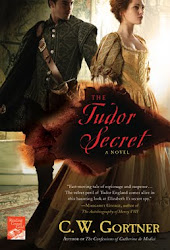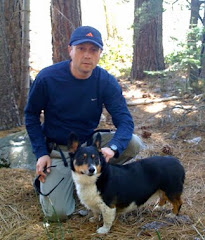 e tapestry, and Glytha, an Anglo Saxon woman bent on revenge who is recruited to embroider the tapestry. I knew relatively little about this time of history, yet Sarah's exquisite prose and ability to portray the fading Anglo Saxon world as the Normans subjugate England drew me right in. I read this book as if I were sipping wine: the language testifies to the beauty we can achieve in writing, without sacrificing complex characterization. Truly, this is one of the finest historical novels that I've read this year. I'm currently reading her second novel. BOOK OF LOVE, set in Italy during the reign of the Borgias, and hope to have her return for a second interview about that book. Also, Sarah and I have discovered, quite by chance, a mutual affinity for Juana la Loca, as you shall see. So, please join me in giving Sarah a warm welcome!
e tapestry, and Glytha, an Anglo Saxon woman bent on revenge who is recruited to embroider the tapestry. I knew relatively little about this time of history, yet Sarah's exquisite prose and ability to portray the fading Anglo Saxon world as the Normans subjugate England drew me right in. I read this book as if I were sipping wine: the language testifies to the beauty we can achieve in writing, without sacrificing complex characterization. Truly, this is one of the finest historical novels that I've read this year. I'm currently reading her second novel. BOOK OF LOVE, set in Italy during the reign of the Borgias, and hope to have her return for a second interview about that book. Also, Sarah and I have discovered, quite by chance, a mutual affinity for Juana la Loca, as you shall see. So, please join me in giving Sarah a warm welcome! Sarah Bower began writing around the age of four, and would probably have begun earlier except that she hadn’t yet learned to write. She won her first literary prize when she was nine and had produced four novels – of which the less said the better – before she was sixteen. The trauma of being laughed at by a careers teacher when she told her she wanted to be a novelist stopped her writing for twenty years, during which time she married, brought up a family and worked in various jobs from running a children’s hospice to selling cheese on a market stall. The writing came back gradually, under the influence of good friends who grew awfully fed up with her self-deprecation! The Needle in the Blood was begun during her creative writing MA course at the University of East Anglia, which she completed in 2002. She was shortlisted for the Curtis Brown scholarship for that year. The novel was published in the UK in 2007 and in the US in spring 2008. Her second novel, The Book of Love, was recently published in the UK and is planned for publication in the US in 2009. Sarah lives in rural Suffolk with her husband, two golden retrievers, two menopausal chickens and a very ancient and imperious cat. She has two grown up sons and a gorgeous grandson. She teaches creative writing at the University of East Anglia and helps to organize Norwich’s annual New Writing Worlds festival. She was UK Co-ordinating Editor of the Historical Novels Review for two years.
You can read more about her at www.snowbooks.com/sarahbower
You can read more about her at www.snowbooks.com/sarahbower
1. Congratulations on the publication of NEEDLE IN THE BLOOD. It's truly an honor to have you with us. Set during the Norman conquest of Britain, THE NEEDLE IN THE BLOOD offers a fascinating look at the making of the Bayeux Tapestry through the tumultuous love affair between an Anglo Saxon woman, Gytha, and the bishop who commissioned the hanging itself, Odo of Bayeux, brother to William the Conqueror. This is an exquisite, layered novel, in which both Odo and Gytha battle not only their loyalties to their respective bloods, but a society in midst of upheaval and transformation, in which winners and losers are not so easily identified and sacrifice and loss forge the road to a new world. What inspired you to write about these people and their link with the famous Tapestry?
Christopher, thank you for your kind words and it is, of course, very exciting to join the ranks of published historical novelists. There are really two answers to your question. The short one is Simon Schama. Some years back he made a wonderful TV series called The History of Britain and during one episode, showed an image from the Bayeux Tapestry of a woman and child fleeing a burning house. This, he said, was the earliest image in Western art of what war does to civilians. Whether or not that’s true, it made me sit up and take notice of the Tapestry for the first time. This leads to my second, less definable reason.
For us in England, the Bayeux Tapestry is what I can best describe as the wallpaper to our history. Its images are so familiar we hardly notice them. They have been appropriated for everything from political cartoons to table mats. The culture the Normans brought with them has become deeply embedded in English life, in place names, in people’s names. (My own sons are called Guy and Hugh, both Norman French names). The literary descendants of Odo and his ilk are figures as quintessentially English as Lord Emsworth! So I suppose, as well as wanting to revisit a great work of art, I wanted to look at a point in our history which feels both very distant but very immediate. I thought there were tensions there from which I might craft a story.
2. THE NEEDLE IN THE BLOOD features an unflinching look at the less savory aspects of the Norman Conquest, especially the losses suffered by the Anglo Saxons. Gytha starts out seeking revenge only to find herself swept up in Odo’s world; she eventually is able to craft a new existence for herself out of the rubble of her past, but for others, like Edith Swan Neck, the known world ceases to exist and so do they. What types of challenges did you encounter while researching this particular story, with its differing viewpoints on the Conquest? What surprising or interesting facts did you discover about the women and men who figure in your novel?
Gosh, where to begin? I suppose the main thing was that I found myself forced to look at the Conquest from the Norman viewpoint. There is a wealth of literature, from Walter Scott to Julian Rathbone, which deals with the aftermath of the invasion from the point of view of the ‘poor, oppressed Saxons’, and I must confess I had expected to be writing along the same lines myself. While my storytelling antennae perked up at the tensions I could exploit between a group of Anglo Saxon, women embroiderers and their male, Norman patron, I originally conceived the novel entirely from the women’s viewpoint. But gradually, something began to happen – everywhere I turned in my researches and speculations, there was Odo.
The Bayeux Tapestry is a strange anomaly, both very familiar and utterly mysterious. No-one knows for sure who commissioned it or why, but Odo has long been the most popular contender because of the way he is represented in it, and because it received its first public showing at the dedication of his new cathedral in 1077. Certainly nothing I read persuaded me otherwise, though I fully respect the alternative views expressed by a range of academic historians who know far more than I do. I began to be absolutely fascinated by Odo, whose life seems to fall into two very distinct halves, divided by the Conquest. This led me to speculate about the psychological effect it had had on him, and, by extension, on the conquerors in general. It seems to me, given the huge risk they took, that they might well have suffered from the trauma almost as much as the people they conquered. Their lives were utterly changed too, they couldn’t go home again either. The figure of Tom/Sebastian in the novel is very much an alter ego for Odo.
So, to come back to the question, I think the big surprise was that I found myself writing a much more complicated book than I had originally envisaged, and tackling a very masculine viewpoint, which was also more than I’d bargained for! I was also surprised to discover that William abolished slavery and the death penalty in England, and that the Normans introduced rabbits and peas to this country.
3. A key element of the novel is the gathering of a disparate group of women to work on what has become known as the Bayeux Tapestry. While technically not a tapestry but rather an embroidered hanging, it alchemizes into a reflection of the women themselves, carrying their secrets and transforming the Norman vision of the Conquest into something far more mysterious. I loved the fact that Gytha sews figures from Aesop’s fables into the fabric and that the blood of Alwys becomes part of it. How much of your interpretation of the creation of the Tapestry is based on fact and how much is product of your imagination? Did these women actually exist as you describe them, and if not, how did you go about selecting them to correspond with what is known from historical record?
As I’ve already indicated, very little is actually known about the making of the Tapestry. We believe it was made in England, because England was the place for embroidery at that period. Just as today you might want your shoes made in Milan or your suits on Savile Row, you would come to England for your altar cloths or embroidered banners. There was a notable embroidery workshop at Saint Augustine’s Monastery in Canterbury – where ‘my’ Tapestry ends up being finished – and this would tie in logically with Odo, whose base of operations as Earl of Kent was Canterbury.
As I’ve already indicated, very little is actually known about the making of the Tapestry. We believe it was made in England, because England was the place for embroidery at that period. Just as today you might want your shoes made in Milan or your suits on Savile Row, you would come to England for your altar cloths or embroidered banners. There was a notable embroidery workshop at Saint Augustine’s Monastery in Canterbury – where ‘my’ Tapestry ends up being finished – and this would tie in logically with Odo, whose base of operations as Earl of Kent was Canterbury.
Embroiders might be men or women. In the later Middle Ages, when the guilds became influential, most embroidery workshops were owned and supervised by men, even if women worked in them, but at this early period a number of women owned businesses also, which gave me a basis for creating quite independent female characters like Gytha and Agatha. Others, such as Judith or Meg, began as illustrations of the kind of plight which might befall women living through the Conquest and its aftermath, but of course they developed lives of their own as the novel progressed. As for the coded images in the borders, such as the use of certain of Aesop’s fables, I am hugely indebted to the work of David J. Bernstein, whose book, The Mystery of the Bayeux Tapestry, ‘unpicks’ the borders in a scholarly but accessible and intriguing way.
4. Your novel features various viewpoints, including that of Odo of Bayeux, a man of the Church who has an illegitimate son and falls in love with Gytha; and his sister Agatha, who flees an unwanted betrothal for the cloister and develops an unrequited love for woman. While much of today’s historical fiction is marketed for a female audience, I felt your novel transcended this limitation and can be equally enjoyed by both sexes. Do you believe that historical fiction writers today should deliberately choose beforehand the gender of their target audience? Is there anything in particular you did in this book to address this issue?
I’m delighted you think the novel transcends the gender divide. Marketing is, of course, essential to the life of a published book. Although it may grieve us to think this, once our words are packaged between covers and lined up on the shelves in bookstores, they become consumer products like any other. I absolutely don’t believe, however, that any writer who sets out to write for a specific audience, rather than for her own creative need and for the lives of the characters that gives rise to, will succeed in producing a novel worth reading. The best books are unique, they defy the way they’re sold and their message is not commercial but emotional and philosophical. I teach creative writing now at my old university, and my heart always sinks when a student tells me s/he has a plan to be the next Stephen King or Philippa Gregory. That’s just not the way it works. We all have to find our own, individual voice.
I’m delighted you think the novel transcends the gender divide. Marketing is, of course, essential to the life of a published book. Although it may grieve us to think this, once our words are packaged between covers and lined up on the shelves in bookstores, they become consumer products like any other. I absolutely don’t believe, however, that any writer who sets out to write for a specific audience, rather than for her own creative need and for the lives of the characters that gives rise to, will succeed in producing a novel worth reading. The best books are unique, they defy the way they’re sold and their message is not commercial but emotional and philosophical. I teach creative writing now at my old university, and my heart always sinks when a student tells me s/he has a plan to be the next Stephen King or Philippa Gregory. That’s just not the way it works. We all have to find our own, individual voice.
5. Can you tell us about methods that you employ to give your characters authenticity? Of the characters in NEEDLE IN THE BLOOD, which are your favorites?
Favourites? Well, Odo, of course. If I didn’t say that, he’d probably come back to haunt me! I had a strangely troubled relationship with Gytha because she’s so prickly, and wanted to give Meg a good shaking, but I love Agatha for her self-discipline and her intellect and Alwys for her barminess, and I have fondness for Robert and Fulk because they’re decent blokes.
The question of characters’ authenticity goes, I think, to the dark heart of the creative process. On the surface, there are all kinds of tricks I’m sure all writers use – imagining a character’s favourite possessions, thinking about the way they dress, all that stuff which goes towards building up a picture. But that’s external. I find I usually begin a novel with fairly clear ideas about those things, then at some indefinable point I move into what Margaret Atwood has called ‘negotiating with the dead’ (particularly apposite for those of us who write about real historical figures!) I can’t predict this, and it can be terrifying as well as magical. It’s also really hard to define without sounding as though I ought to be taken away by men in white coats, because the best I can say is that the characters begin to talk to me, to tell me their stories so that I become a kind of conduit. I do believe the best fiction is character led, that plot arises out of staying true to the way your characters behave and not trying to force them into behaviours which don’t suit them. So I guess I just follow where they lead.
6. How do you think your novel speaks to today’s reader or how do the events you evoke resonate for today’s world?
For me, the main message of the book for today’s world is about perspective, taking a long view. There is an unattractive and ill-informed national conversation going on in the UK about the nature of Britishness, and how it involves – basically – being white and English-speaking. What I would like people to take away from this book, as well as their enjoyment of it, is a more subtle, complex and informed sense of identity. In 1066, this island was inhabited predominantly by people of Scandinavian and Germanic origin. It was conquered by a bunch of French speaking adventurers who had come originally from what is now Sweden. Our country, like every other, is polyglot, a mixture, a long history of people shifting hither and thither, intermarrying, fighting, negotiating their political and cultural differences until they come to some kind of accommodation. By writing from the viewpoint of people on both sides of the Saxon-Norman divide, I hope I’ve shown how this happens on the individual level and how everyone has equal value, regardless of their background.
Or, of course, their gender. I’m sure you would agree with me that Odo doesn’t get the better of the women for all his swagger!
7. Please, tell us about your next project.
Ah, well now, perhaps I should let you do that for me! By a marvelous coincidence, Queen Juana ‘La Loca’ is the subject of my next book. This makes it a particular thrill for me to have this conversation with you just as The Last Queen is shortly to hit the bookshelves, though also somewhat nerve-wracking. I first stumbled across Juana while researching my second novel, The Book of Love, which is set in a similar period. The legendary images of her lurking in the chimney breast at Medina del Campo and her curious relationship with her husband (trying not to give anything away here) completely captivated me. It’s early days yet, but I’m really enjoying the search for a voice for such an extraordinary woman. I’m also working on a possible short story collection, though these will all be contemporary not historical.
The question of characters’ authenticity goes, I think, to the dark heart of the creative process. On the surface, there are all kinds of tricks I’m sure all writers use – imagining a character’s favourite possessions, thinking about the way they dress, all that stuff which goes towards building up a picture. But that’s external. I find I usually begin a novel with fairly clear ideas about those things, then at some indefinable point I move into what Margaret Atwood has called ‘negotiating with the dead’ (particularly apposite for those of us who write about real historical figures!) I can’t predict this, and it can be terrifying as well as magical. It’s also really hard to define without sounding as though I ought to be taken away by men in white coats, because the best I can say is that the characters begin to talk to me, to tell me their stories so that I become a kind of conduit. I do believe the best fiction is character led, that plot arises out of staying true to the way your characters behave and not trying to force them into behaviours which don’t suit them. So I guess I just follow where they lead.
6. How do you think your novel speaks to today’s reader or how do the events you evoke resonate for today’s world?
For me, the main message of the book for today’s world is about perspective, taking a long view. There is an unattractive and ill-informed national conversation going on in the UK about the nature of Britishness, and how it involves – basically – being white and English-speaking. What I would like people to take away from this book, as well as their enjoyment of it, is a more subtle, complex and informed sense of identity. In 1066, this island was inhabited predominantly by people of Scandinavian and Germanic origin. It was conquered by a bunch of French speaking adventurers who had come originally from what is now Sweden. Our country, like every other, is polyglot, a mixture, a long history of people shifting hither and thither, intermarrying, fighting, negotiating their political and cultural differences until they come to some kind of accommodation. By writing from the viewpoint of people on both sides of the Saxon-Norman divide, I hope I’ve shown how this happens on the individual level and how everyone has equal value, regardless of their background.
Or, of course, their gender. I’m sure you would agree with me that Odo doesn’t get the better of the women for all his swagger!
7. Please, tell us about your next project.
Ah, well now, perhaps I should let you do that for me! By a marvelous coincidence, Queen Juana ‘La Loca’ is the subject of my next book. This makes it a particular thrill for me to have this conversation with you just as The Last Queen is shortly to hit the bookshelves, though also somewhat nerve-wracking. I first stumbled across Juana while researching my second novel, The Book of Love, which is set in a similar period. The legendary images of her lurking in the chimney breast at Medina del Campo and her curious relationship with her husband (trying not to give anything away here) completely captivated me. It’s early days yet, but I’m really enjoying the search for a voice for such an extraordinary woman. I’m also working on a possible short story collection, though these will all be contemporary not historical.
Thank you for taking the time to visit with us, Sarah!












